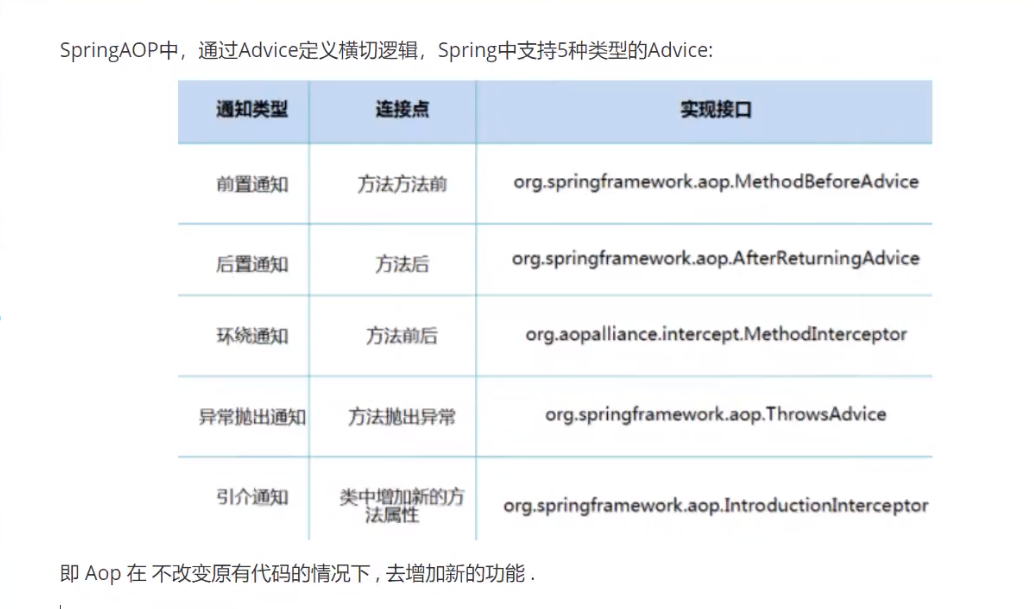Spring学习
1、Spring介绍
1.1、简介
-
Spring: 春天 --> 给软件行业带来了春天!
-
Spring框架雏形:interface21
-
Spring Framework创始人, Rod Johnson.
-
-
SSH: Strust2 + Spring + Hibernate
-
SSM:SpringMVC + Spring + Mybatis
1 <!-- https://mvnrepository.com/artifact/org.springframework/spring-webmvc --> 2 <dependency> 3 <groupId>org.springframework</groupId> 4 <artifactId>spring-webmvc</artifactId> 5 <version>5.2.0.RELEASE</version> 6 </dependency> 7 <!-- https://mvnrepository.com/artifact/org.springframework/spring-jdbc --> 8 <dependency> 9 <groupId>org.springframework</groupId> 10 <artifactId>spring-jdbc</artifactId> 11 <version>5.2.0.RELEASE</version> 12 </dependency>
1.2、优点
-
Spring是一个开源的免费的框架(容器)!
-
Spring是一个轻量级的、非入侵式的框架!
-
控制翻转(IOC),面向切面编程(AOP)!
-
支持事务的处理,对框架整合的支持!
总结:Spring就是一个轻量级的控制反转(IOC)和面向切面编程(AOP)的框架!
1.3、组成

1.4、拓展
现代化的java开发就是基于Spring的开发!
-
Spring Boot
-
一个快速开发的脚手架
-
基于SpringBoot开源快速的开发单个微服务。
-
约定大于配置!
-
-
Spring Cloud
-
Spring Cloud是基于SpringBoot实现的。
-
因为现在大多数公司都在使用SpringBoot进行快速开发,学习SpringBoot的前提,需要完成掌握Spring及SpringMVC,承上启下的作用!
弊端:配置十分繁琐。
2、IOC理论推导
-
UserDao 接口
1 public interface UserDao { 2 public void getUser(); 3 }
-
UserDaoImpl 实现类
1 public class UserDaoImpl implements UserDao { 2 public void getUser() { 3 System.out.println("默认获取用户"); 4 } 5 }
-
UserService 业务接口
1 public interface UserService { 2 public void getUser(); 3 }
-
UserServiceImpl 业务实现类
1 public class UserServiceImpl implements UserService { 2 3 //之前,进行写死 4 //UserDao userDao = new UserDaoImpl(); 5 6 private UserDao userDao; 7 8 //现在,利用set进行动态实现值的注入!使用什么UserDao的实现类方法,就注入什么方法实现类 9 public void setUserDao(UserDao userDao){ 10 this.userDao = userDao; 11 } 12 13 public void getUser() { 14 userDao.getUser(); 15 } 16 }
-
测试类
1 public class newTest { 2 3 public static void main(String[] args) { 4 //用户实际上调用的是业务层代码,dao层他们不需要接触 5 UserService userService = new UserServiceImpl(); 6 7 ((UserServiceImpl) userService).setUserDao(new MysqlUserImpl()); 8 9 userService.getUser(); 10 } 11 }
在我们之前的业务中,用户的需求可能会影响我们原来的代码,我们需要根据用户的需求去修改原代码!如果程序代码量十分大,修改一次的成本价十分昂贵!
我们使用一个Set接口实现:
1 private UserDao userDao; 2 3 //利用set进行动态实现值的注入! 4 public void setUserDao(UserDao userDao){ 5 this.userDao = userDao; 6 }
-
之前,程序是主动创建对象!控制权在程序员手上!
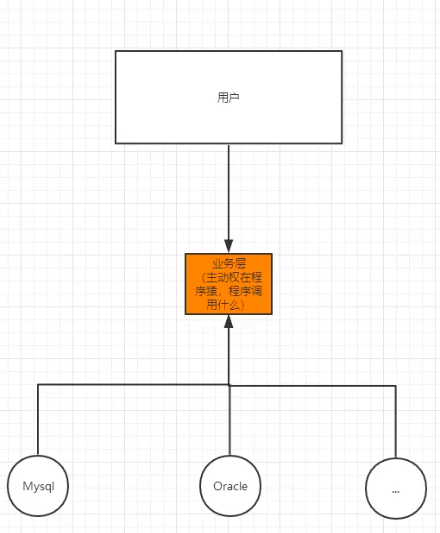
-
使用set注入之后,程序不再具有主动性,而是变成了被动的接受对象。
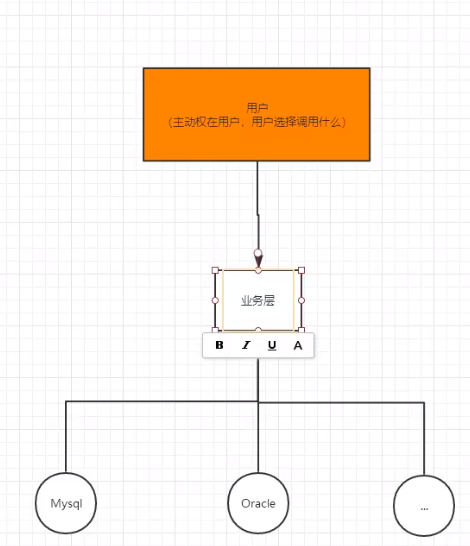
这种思想,从本质上解决了问题,我们程序员不用再去管理对象的创建了。系统的耦合性大大降低,可以更加专注的在业务实现上!这是IOC的原型!
IOC本质
控制反转IoC(inversion of Control),是一种设计思想,DI(依赖注入)是实现IoC的一种方法,也有人认为DI只是IoC的另一种说法。没有IoC的程序中,我们使用面向对象编程,对象的创建与对象间的依赖关系完全硬编码在程序中,对象的创建由程序自己控制,控制反转后将对象的创建转移给第三方,个人认为所谓控制反转就是:获得依赖对象的方式反转了。
采用XML方式配置Bean的时候,Bean的定义信息是和实现分离的,而采用注解的方式可以把两者合为一体,Bean的定义信息直接以注解的形式定义在实现类中,从而达到了零配置的目的。
控制反转是一种通过描述(xml或注解)并通过第三方去生产或获取特定对象的方式。在Spring中实现控制反转的是IoC容器,其实现方法是依赖注入(Dependency injection,DI)。
3、HelloSpring
这个过程就叫控制反转:
-
控制:谁来控制对象的创建,传统应用程序的对象是由程序本身控制创建的,使用Spring后,对象是由Spring来创建。
-
反转:程序本身不创建对象,而变成被动的接收对象。
-
依赖注入:就是利用set方法来进行注入的。
-
IOC是一种编程思想,由主动的编程变成被动的接收。
-
可以通过newClassPathXmlApplicationContext去浏览一下底层代码。
-
要实现不同的操作,只需要在xml配置文件中进行修改,所谓的IoC:对象由Spring来创建,管理,装配!
4、IOX创建对象的方式
-
使用无参构造创建对象,默认!
-
假设我们要使用有参构建对象。
-
下标赋值
1 <!--第一种:下标赋值--> 2 <bean id="user" class="com.zmz.pojo.User"> 3 <constructor-arg index="0" value="zmz"/> 4 </bean>
-
类型赋值
1 <!--第二种:通过类型赋值,不建议使用,以为如果有参构造中有两个相同类型的参数,就很容易混淆--> 2 <bean id="user" class="com.zmz.pojo.User"> 3 <constructor-arg type="java.lang.String" value="zmz"/> 4 </bean>
-
参数名赋值
1 <!--第三种:直接通过参数名来设置,建议使用--> 2 <bean id="user" class="com.zmz.pojo.User"> 3 <constructor-arg name="name" value="zmz"/> 4 </bean>
总结:在配置文件加载的时候,容器中管理的对象就已经初始化了!
-
5、Spring配置
5.1、别名
1 <!--别名:如果添加了别名,我们也可以通过这个别名获取到这个对象--> 2 <alias name="user" alias="userNew"/>
5.2、Bean的配置
1 <!-- 2 id: bean的唯一标识符,也就是相当于我们学过的对象名 3 class: bean 对象所对应的全限定名: 包名 + 类名 4 name: 也是别名,而且name 可以同时取多个别名,权限比alias高 5 --> 6 <bean id="user" class="com.zmz.pojo.User" name="user2,u2 u3;u4"> 7 <constructor-arg name="name" value="zmz"/> 8 </bean>
5.3、import配置
这个import,一般用于团队开发使用,它可以将多个配置文件,导入合并为一个。
假设,现在项目中有多个人开发,这三个人负责不同的类开发,不同的类需要注册在不同的bean中,我们可以利用import将所有人的beans.xml合并为要给总的!
-
张三
-
李四
-
王五
-
applicationContext.xml
1 <import resource="beans.xml"/> 2 <import resource="beans1.xml"/> 3 <import resource="beans2.xml"/>
使用的时候,直接使用总的配置就可以了。
6、DI依赖注入
6.1、构造器注入
就是construct arg哪个,之前的哪个。
6.2、Set方式注入【重点】
-
依赖注入:Set注入!
-
依赖:bean对象的创建依赖于容器
-
注入:bean对象中的所有属性,由容器来注入!
-
【环境搭建】
-
复杂类型
1 public class Address { 2 private String address; 3 4 public String getAddress() { 5 return address; 6 } 7 8 public void setAddress(String address) { 9 this.address = address; 10 } 11 }
-
真实测试对象
public class Student { private String name; private Address address; private String[] books; private List<String> hobbys; private Map<String,String> card; private Set<String> games; private String wife; private Properties info;
-
applicationContext.xml
<?xml version="1.0" encoding="UTF-8"?> <beans xmlns="http://www.springframework.org/schema/beans" xmlns:xsi="http://www.w3.org/2001/XMLSchema-instance" xsi:schemaLocation="http://www.springframework.org/schema/beans https://www.springframework.org/schema/beans/spring-beans.xsd"> <bean id="student" class="com.zmz.pojo.Student"> <!--第一种方式:普通注入,value--> <property name="name" value="zmz"/> </bean> </beans>
-
测试类
@Test public void test01(){ ApplicationContext context = new ClassPathXmlApplicationContext("applicationContext.xml"); Student student = (Student) context.getBean("student"); System.out.println(student.getName()); } }
完善注入信息
<?xml version="1.0" encoding="UTF-8"?> <beans xmlns="http://www.springframework.org/schema/beans" xmlns:xsi="http://www.w3.org/2001/XMLSchema-instance" xsi:schemaLocation="http://www.springframework.org/schema/beans https://www.springframework.org/schema/beans/spring-beans.xsd"> <bean id="Adress" class="com.zmz.pojo.Address"> <property name="address" value="xj"/> </bean> <bean id="student" class="com.zmz.pojo.Student"> <!--第一种方式:普通注入,value--> <property name="name" value="zmz"/> <!--ref--> <property name="address" ref="Adress"/> <!--数组注入--> <property name="books"> <array> <value>红楼梦</value> <value>西游记</value> <value>三国演义</value> <value>水浒传</value> </array> </property> <!--list注入--> <property name="hobbys"> <list> <value>听歌</value> <value>读书</value> <value>打游戏</value> </list> </property> <!--Map注入--> <property name="card"> <map> <entry key="身份证号" value="111111111111111111"/> <entry key="银行卡号" value="111111111111111111"/> </map> </property> <!--Set注入--> <property name="games"> <set> <value>lol</value> <value>王者荣耀</value> </set> </property> <!--null注入--> <property name="wife"> <null/> </property> <!--Properties注入--> <property name="info"> <props> <prop key="学号">20172500000</prop> <prop key="性别">男</prop> <prop key="姓名">zmz</prop> </props> </property> </bean> </beans>
输出:
/*
* Student{
* name='zmz',
* address=Address{address='xj'},
* books=[红楼梦, 西游记, 三国演义, 水浒传],
* hobbys=[听歌, 读书, 打游戏],
* card={ 身份证号=111111111111111111,
* 银行卡号=111111111111111111},
* games=[lol, 王者荣耀],
* wife='null',
* info={学号=20172500000, 性别=男, 姓名=zmz}}
* */
6.3、拓展方式注入
我们可以使用p命令空间和c命令空间进行注入
官方解释:
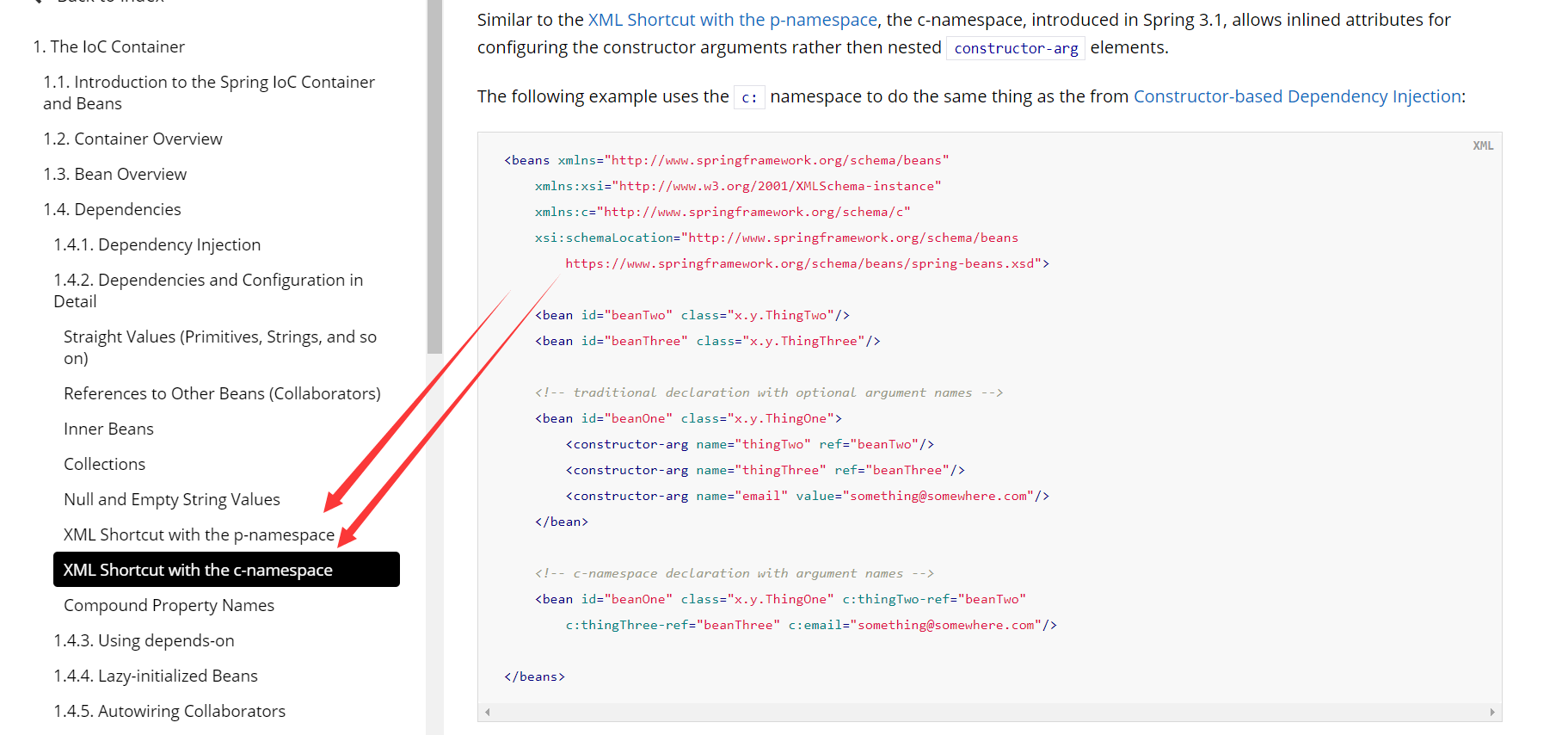
使用:
<?xml version="1.0" encoding="UTF-8"?> <beans xmlns="http://www.springframework.org/schema/beans" xmlns:xsi="http://www.w3.org/2001/XMLSchema-instance" xmlns:p="http://www.springframework.org/schema/p" xmlns:c="http://www.springframework.org/schema/c" xsi:schemaLocation="http://www.springframework.org/schema/beans https://www.springframework.org/schema/beans/spring-beans.xsd"> <!--p命名空间注入,可以直接注入属性的值:properties--> <bean id="user" class="com.zmz.pojo.User" p:name="zmz" p:age="12"/> <!--c命名空间注入,可以通过构造器注入属性的值:constructor--> <bean id="user2" class="com.zmz.pojo.User" c:name="zmz" c:age="12"/> </beans>
测试:
@Test public void test02(){ ApplicationContext context = new ClassPathXmlApplicationContext("UserBeans.xml"); User user = context.getBean("user2", User.class); System.out.println(user.toString()); }
注意点:p命名空间和c命名空间不能直接使用,需要导入xml约束!
xmlns:p="http://www.springframework.org/schema/p"
xmlns:c="http://www.springframework.org/schema/c"
6.4、Bean的作用域
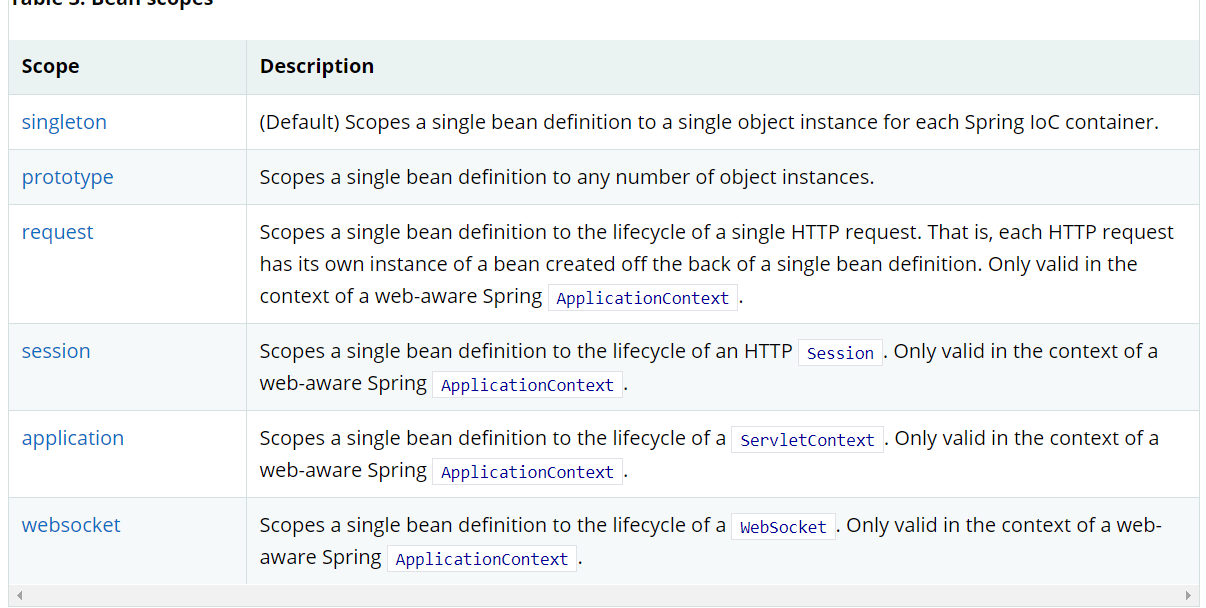
-
单例模式(Spring默认机制)(单线程尽量使用这个)
<!--默认为单例模式(singleton),就是指全局内共享这一个值--> <bean id="user2" class="com.zmz.pojo.User" c:name="zmz" c:age="12" scope="singleton"/>
-
原型模式:每次从容器中get的时候,都会产生一个新对象!(多线程尽量使用这个)
<bean id="user2" class="com.zmz.pojo.User" c:name="zmz" c:age="12" scope="prototype"/>
-
其余的request、session、application这些个只能在web开发中使用到!
7、Bean的自动装配
-
自动装配是Spring满足bean依赖一种方式!
-
Spring会在上下文中自动寻找,并自动给bean装配属性!
在Spring中有三种装配的方式
-
在xml中显示的配置
-
在java中显示配置
-
隐式的自动装配bean
7.1、测试
环境搭建:一个人有两个宠物!
7.2、ByName自动装配
<bean id="dog" class="com.zmz.pojo.Dog"/> <bean id="cat" class="com.zmz.pojo.Cat"/> <!-- byName:会自动在容器上下文中查找,和自己对象set方法后面得值对应得beanid! --> <bean id="people" class="com.zmz.pojo.People" autowire="byName"> <property name="name" value="zmz"/> </bean>
7.3、ByType自动装配
<bean class="com.zmz.pojo.Dog"/> <bean class="com.zmz.pojo.Cat"/> <!-- byType:会自动在容器上下文中查找,和自己对象属性类型相同的bean! --> <bean id="people" class="com.zmz.pojo.People" autowire="byType"> <property name="name" value="zmz"/> </bean>
小结:
-
byName的时候,需要保证所有的bean的id唯一,并且这个bean需要和自动注入的属性的set方法的值一致!
-
byType的时候,需要保证所有bean的class唯一,并且这个bean需要和自动注入的属性的类型一致!
7.4、使用注解实现自动装配
jdk1.5支持的注解,Spring2.5就支持注解了
要使用注解须知:<context:annotation-config/>
<?xml version="1.0" encoding="UTF-8"?> <beans xmlns="http://www.springframework.org/schema/beans" xmlns:xsi="http://www.w3.org/2001/XMLSchema-instance" xmlns:context="http://www.springframework.org/schema/context" xsi:schemaLocation="http://www.springframework.org/schema/beans https://www.springframework.org/schema/beans/spring-beans.xsd http://www.springframework.org/schema/context https://www.springframework.org/schema/context/spring-context.xsd"> <context:annotation-config/> </beans>
@Autowired
可以直接在属性上使用即可!也可以在set方式上使用!
使用Autowired我们可以不用编写Set方法了,前提是你这个自动装配的属性在IOC(Spring)容器中存在,且符合名字byName!
科普:
@Nullable 字段标记了这个注解,说明这个字段可以为null public @interface Autowired{ boolean required() default true; }
测试代码:
public class People { private String name; //如果显示的定义了Autowired的required属性为false,说明这个对象可以为null,否则不允许为空 @Autowired(required = false) private Dog dog; @Autowired private Cat cat; }
如果@Autowired自动装配的环境比较复杂,自动装配无法通过一个注解【@Autowired】完成的时候,我们可以使用@Qualifier(value="xxx")去配置@Autowired的使用,指定一个唯一的bean对象注入!
public class People { private String name; //如果显示的定义了Autowired的required属性为false,说明这个对象可以为null,否则不允许为空 @Autowired @Qualifier(value = "dog222") private Dog dog; @Autowired @Qualifier(value = "cat2") private Cat cat; }
<!--开启注解的支持--> <context:annotation-config/> <bean id="dog222" class="com.zmz.pojo.Dog"/> <bean id="cat222" class="com.zmz.pojo.Cat"/> <bean id="dog2" class="com.zmz.pojo.Dog"/> <bean id="cat2" class="com.zmz.pojo.Cat"/>
java的原生注解注入:@Resource(name="cat2")
public class People { private String name; @Resource(name = "dog222") private Dog dog; @Resource(name = "cat2") private Cat cat; }
小结:
@Resource和@Autowired的区别:
-
都是用来自动装配的,都可以放在属性字段上
-
@Autowired 通过byType的方式实现,而且必须要求这个对象存在!【常用】
-
@Resource 默认通过byname的方式实现,如果找不到名字,则通过byType实现!如果两个都找不到的情况下,就报错!【常用】
-
执行顺序不同:@Autowired 通过byType的方式实现。
8、使用注解开发
在Spring4之后,要使用注解开发,必须要保证aop的包导入了。
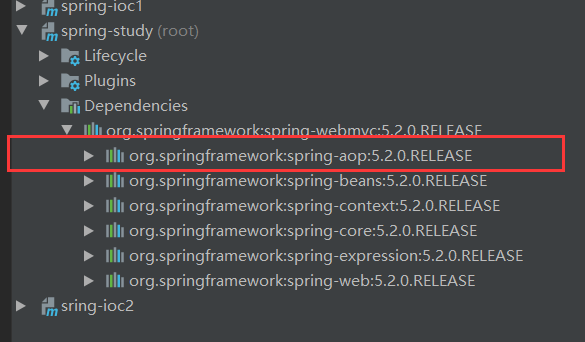
使用注解需要导入context约束,增加注解的支持!
-
bean
@Component public class User { ... }
<?xml version="1.0" encoding="UTF-8"?> <beans xmlns="http://www.springframework.org/schema/beans" xmlns:xsi="http://www.w3.org/2001/XMLSchema-instance" xmlns:context="http://www.springframework.org/schema/context" xsi:schemaLocation="http://www.springframework.org/schema/beans https://www.springframework.org/schema/beans/spring-beans.xsd http://www.springframework.org/schema/context https://www.springframework.org/schema/context/spring-context.xsd"> <!--指定要扫描的包,这个包下得注解就会生效--> <context:component-scan base-package="com.zmz.pojo"/> <!--开启注解方式--> <context:annotation-config/> </beans>
-
属性如何注入
@Component public class User { //相当于 <properties id="name" value="zmz"/> @Value("zmz") private String name; //@Value("zmz")也可以放到set上面 public void setName(String name) { this.name = name; } }
-
衍生的注解
@Component 有几个衍生注解,我们再web开发中,会按照mvc三层架构分层!
-
dao 【@Repository】
-
service 【@Service】
-
controller 【@Controller】
这四个注解功能都是一样得,都是代表将某个类注册到Spring中,装配Bean.
-
-
自动装配置
注解说明: - @Autowired: 自动装配通过类型,名字。如果Autowired不能唯一自动装配上属性,则需要通过@Qualifier(value = "xxx") - @Nullable : 字段标记了这个注解,说明这个字段可以为null; - @Resource: 自动装配通过名字,类型。 - @Component:组件,放在类上,说明这个类被Spring管理了,就是bean!
-
作用域
@Scope("singleton") public class User { ... } -
小结
xml与注解:
-
xml更加万能,适用于任何场合!维护简单方便;
-
注解,不是自己类使用不了,维护相对复杂!
xml与注解最佳实践:
-
xml用来管理bean;
-
注解只负责完成属性的注入;
-
我们在使用过程中,只需要注意一个问题:必须让注解生效,就需要开启注解的支持;
<!--指定要扫描的包,这个包下得注解就会生效--> <context:component-scan base-package="com.zmz"/> <!--开启注解方式--> <context:annotation-config/>
-
9、使用java的方式配置Spring
我们现在要完全不使用Spring的xml配置,全权交给Java来做!
JavaConfig是Spring的一个子项目,在Spring4之后,他成为了一个核心功能!

实体类
//这个注解的意思是,说明这个类被Spring接管了,注册到了容器中 @Component public class User { //属性注入值 @Value("zmz") private String name; public String getName() { return name; } public void setName(String name) { this.name = name; } }
配置类:
//@Configuration代表这是一个配置类,等价于beans.xml文件 //这个也是Spring容器托管,注册到容器中,因为他本来就是一个@Component //@Component @ComponentScan("com.zmz.pojo") @Configuration @Import(MyConfig2.class) public class MyConfig { //注册一个bean,就相当于我们之前写的一个bean标签 //这个方法的名字,就相当于bean标签中的id属性 //这个方法的返回值,就相当于bean标签中的class属性 @Bean public User user1(){ return new User(); } }
测试类:
public class Mytest { public static void main(String[] args) { //如果完全使用了配置类方式去做,我们就只能通过AnnotationConfig 上下文来获取容器,通过配置类的class对象加载! ApplicationContext context = new AnnotationConfigApplicationContext(MyConfig.class); User user1 = context.getBean("user1", User.class); System.out.println(user1.getName()); } }
这种纯Java的配置方式,在SpringBoot中随处可见!
10、代理模式
为什么要学习代理模式?
因为这就是Spring AOP的底层!【SpringAOP和SpringMVC】
代理模式的分类:
-
静态代理
-
动态代理
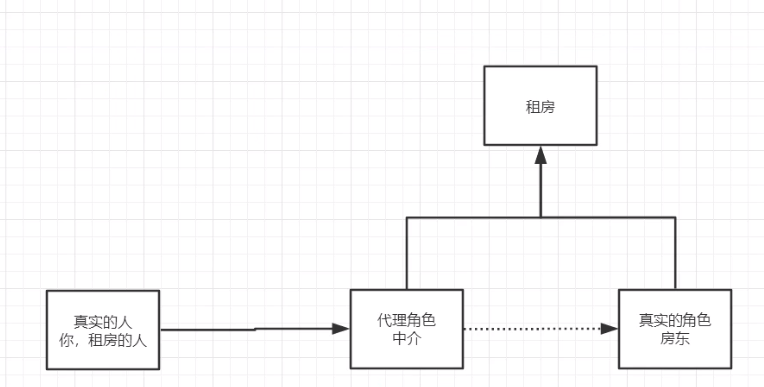
10.1、静态代理
角色分析:
-
抽象角色:一般会使用接口或者抽象类来解决
-
真实角色:被代理的角色
-
代理角色:代理真实角色,代理真实角色后,我们一般会做一些附属操作
-
客户:访问代理对象的人!
代码步骤:
-
接口
//租房 public interface Rent { public void rent(); }
-
真实角色
//房东 public class Host implements Rent { public void rent() { System.out.println("房东带你看房!!!"); } }
-
代理角色
//代理角色 public class Proxy implements Rent{ private Host host; public Proxy() { } public Proxy(Host host) { this.host = host; } public void rent() { seeHouse(); host.rent(); hetong(); fare(); } public void seeHouse(){ System.out.println("中介带你看房"); } public void hetong(){ System.out.println("签合同"); } public void fare(){ System.out.println("收取中介费"); } }
-
客户端访问代理角色
public class Client { public static void main(String[] args) { //房东要租房子 Host host = new Host(); //代理,中介帮房东租房子,但是呢,代理角色一般会有一些附属操作! Proxy proxy = new Proxy(host); //你不用面对房东,直接找中介租房即可! proxy.rent(); } }
代理模式得好处:
-
可以使真实角色得操作更加纯粹!不用去关注一些公共得业务。
-
公共也就交给代理角色!实现了业务得分工!
-
公共业务发生扩展得时候,方便集中管理!
缺点:
-
一个真实角色就会产生一个代理角色;代码量会翻倍,开发效率会变低。
10.2、静态代理再理解

尽量不改变原有代码。
代码步骤:
-
接口
public interface UserService { public void add(); public void delete(); public void update(); public void query(); }
-
真实角色
//真实角色 public class UserServiceImpl implements UserService { public void add() { System.out.println("实现了增加方法"); } public void delete() { System.out.println("实现了删除方法"); } public void update() { System.out.println("update"); } public void query() { System.out.println("query"); } }
-
代理角色
//代理角色 public class UserProxy implements UserService { private UserServiceImpl userService; public void setUserService(UserServiceImpl userService) { this.userService = userService; } public void add() { log("add"); userService.add(); } public void delete() { log("delete"); userService.delete(); } public void update() { log("update"); userService.update(); } public void query() { log("query"); userService.query(); } //日志方法,由代理用户进行增加除真实用户外的方法,不改变UserServiceImpl(真实用户)的代码 //要改变原有真实用户的方法,而不改变真实用户的原有代码则采用代理模式; //方法就是使用代理模式进行实现真实用户的方法之后,再加上自己的方法即可 public void log(String msg){ System.out.println(msg+"方法"); } }
-
客户端访问代理角色
public class Client { public static void main(String[] args) { UserProxy userProxy = new UserProxy(); userProxy.setUserService(new UserServiceImpl()); userProxy.add(); userProxy.delete(); } }
OOP七大原则(尽量去了解):
-
开闭原则;
-
里氏替换原则
10.3、动态代理
-
动态代理和静态代理角色一样
-
动态代理的代理类事动态生成的,不是我们直接写好的!
-
动态代理分为两大类:基于接口的动态代理,基于类的动态代理
-
基于接口--JDK动态代理
-
基于类:cglib
-
java字节码实现:javaAssist
-
需要了解两个类:Proxy,InvocationHandler:调用处理程序
动态代理的好处:
-
可以使真实角色得操作更加纯粹!不用去关注一些公共得业务。
-
公共也就交给代理角色!实现了业务得分工!
-
公共业务发生扩展得时候,方便集中管理!
-
一个动态代理类实现了一个接口,一般就是对应的一类业务
-
一个动态代理类可以代理多个类,只要是实现了同一个接口即可!
代码步骤:
-
接口
//租房 public interface Rent { public void rent(); }
-
真实角色
//房东 public class Host implements Rent { public void rent() { System.out.println("房东带你看房!!!"); } }
-
处理程序类(实现了InvocationHandler)
//处理器,等会我们用这个类,自动生成代理类 public class ProxyInvocationHandler implements InvocationHandler { //被代理的的接口 private Rent rent; public void setRent(Rent rent) { this.rent = rent; } //生成得到代理类 public Object getProxy(){ return Proxy.newProxyInstance(this.getClass().getClassLoader(),rent.getClass().getInterfaces(),this); } //处理代理实例,并返回接口 public Object invoke(Object proxy, Method method, Object[] args) throws Throwable { //按照顺序执行这三个方法,中间的result结果是实现代理角色的方法; seeHouse(); //动态代理的本质,就是使用反射机制实现! Object result = method.invoke(rent, args); fare(); return result; } public void seeHouse(){ System.out.println("中介带看房"); } public void fare(){ System.out.println("收中介费"); } }
-
客户端访问代理角色
public class Client { public static void main(String[] args) { //代理角色 Host host = new Host(); //现在没有代理角色 ProxyInvocationHandler proxyInvocationHandler = new ProxyInvocationHandler(); //通过调用程序处理角色来处理我们要调用的接口对象 proxyInvocationHandler.setRent(host); Rent proxy = (Rent) proxyInvocationHandler.getProxy(); //这里的proxy就是动态生成的,我们并没有写 proxy.rent(); } }
改进代码(即将处理程序类变为通用工具类):
-
接口
public interface UserService { public void add(); public void delete(); public void update(); public void query(); }
-
真实角色
//真实角色 public class UserServiceImpl implements UserService { public void add() { System.out.println("实现了增加方法"); } public void delete() { System.out.println("实现了删除方法"); } public void update() { System.out.println("update"); } public void query() { System.out.println("query"); } }
-
处理程序类(实现了InvocationHandler)
//处理器,等会我们用这个类,自动生成代理类 //将demo3中的变化一下,变为一个通式 public class ProxyInvocationHandler implements InvocationHandler { //被代理的的接口 private Object target; public void setTarget(Object target) { this.target = target; } //生成得到代理类 public Object getProxy(){ return Proxy.newProxyInstance(this.getClass().getClassLoader(),target.getClass().getInterfaces(),this); } //处理代理实例,并返回接口 public Object invoke(Object proxy, Method method, Object[] args) throws Throwable { log(method.getName()); //动态代理的本质,就是使用反射机制实现! Object result = method.invoke(target, args); return result; } public void log(String msg){ System.out.println(msg+"方法"); } }
-
客户端访问代理角色
public class Client { public static void main(String[] args) { //真实角色 UserServiceImpl userService = new UserServiceImpl(); //代理角色不存在 ProxyInvocationHandler proxyInvocationHandler = new ProxyInvocationHandler(); //设置要代理的对象 proxyInvocationHandler.setTarget(userService); //动态生成代理类 //动态代理代理的是接口,所以转为UserService接口类 UserService proxy = (UserService) proxyInvocationHandler.getProxy(); proxy.add(); } }
-
11、AOP
11.1、什么是AOP
AOP为Aspect Oriented Programming的缩写,意为:面向切面编程,通过预编译方式和运行期间动态代理实现程序功能的统一维护的一种技术。AOP是OOP的延续,是软件开发中的一个热点,也是Spring框架中的一个重要内容,是函数式编程的一种衍生范型。利用AOP可以对业务逻辑的各个部分进行隔离,从而使得业务逻辑各部分之间的耦合度降低,提高程序的可重用性,同时提高了开发的效率。
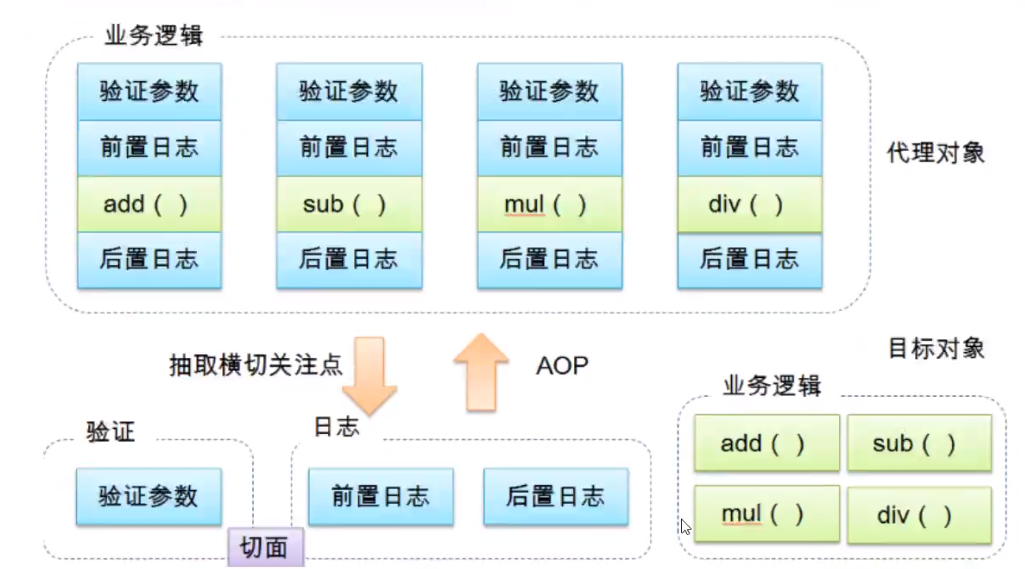
11.2、AOP再Spring中的作用
提供声明式事务;允许用户自定义切面
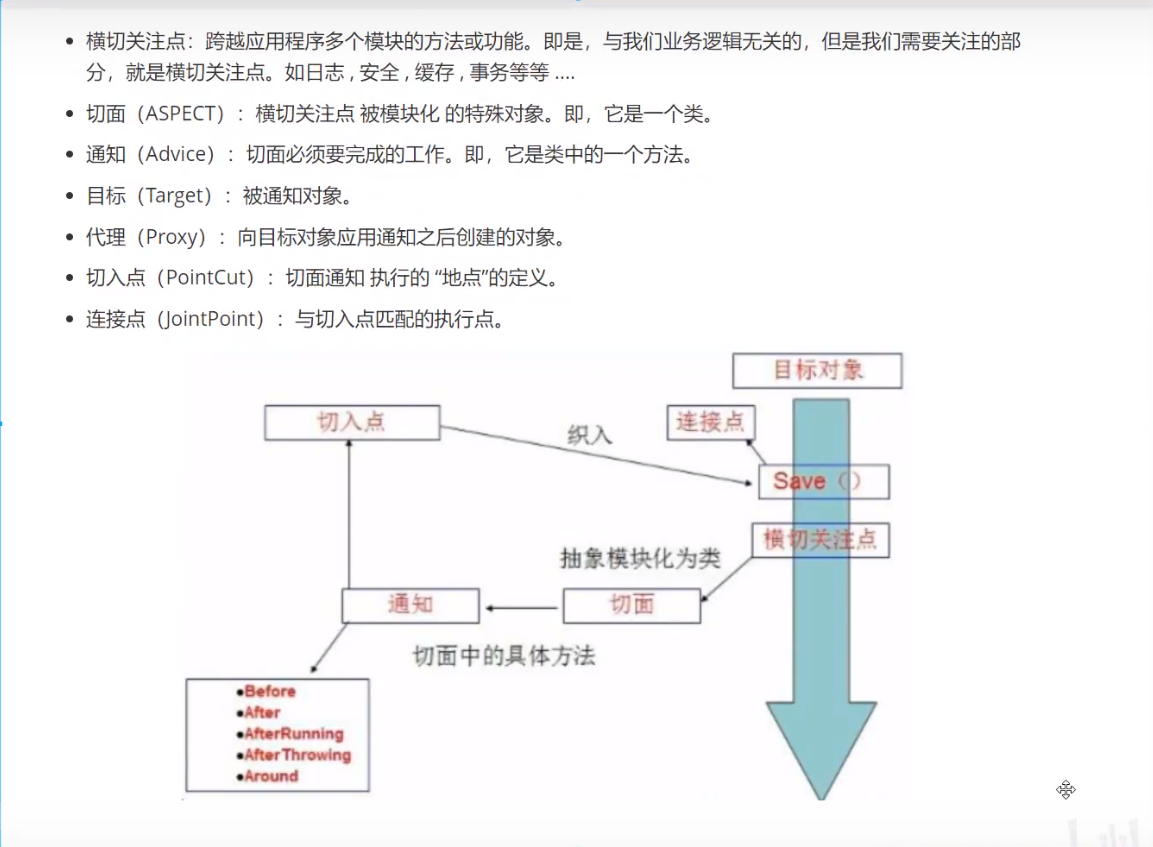
11.3、使用Spring实现AOP
使用AOP织入,需要导入一个依赖包!
<!-- https://mvnrepository.com/artifact/org.aspectj/aspectjweaver --> <dependency> <gourpId>org.aspectj</gourpId> <artifactId>aspectjweaver</artifactId> <version>1.9.4</version> </dependency>
方式一:使用Spring的API接口【主要是SpringAPI接口实现】
代码步骤:
-
接口
public interface UserService { public void add(); public void delete(); public void update(); public void select(); }
-
真实角色
public class UserServiceImpl implements UserService { public void add() { System.out.println("增加了一个用户"); } public void delete() { System.out.println("删除了一个用户"); } public void update() { System.out.println("修改了一个用户"); } public void select() { System.out.println("查询了一个用户"); } }
-
通知
-
前置通知
public class Log implements MethodBeforeAdvice { //method:要执行的目标对象的方法 //args:参数 //target: 目标对象 public void before(Method method, Object[] objects, Object target) throws Throwable { System.out.println(target.getClass().getName()+"类提示:刚刚执行了"+method.getName()+"方法"); } }
-
后置通知
public class AfterLog implements AfterReturningAdvice { //method:要执行的目标对象的方法 //args:参数 //target: 目标对象 //returnValue: 返回值 public void afterReturning(Object returnValue, Method method, Object[] objects, Object target) throws Throwable { System.out.println(target.getClass().getName()+"类提示:刚刚执行了"+method.getName()+"方法,返回结果为:"+returnValue); } }
-
-
applicationContext.xml配置
<?xml version="1.0" encoding="UTF-8"?> <beans xmlns="http://www.springframework.org/schema/beans" xmlns:xsi="http://www.w3.org/2001/XMLSchema-instance" xmlns:aop="http://www.springframework.org/schema/aop" xsi:schemaLocation="http://www.springframework.org/schema/beans https://www.springframework.org/schema/beans/spring-beans.xsd http://www.springframework.org/schema/aop https://www.springframework.org/schema/aop/spring-aop.xsd"> <!--注册bean--> <bean id="userService" class="com.zmz.service.UserServiceImpl"/> <bean id="log" class="com.zmz.log.Log"/> <bean id="afterLog" class="com.zmz.log.AfterLog"/> <!--方式一:使用原生Spring API接口--> <!--配置aop:需要导入aop的约束--> <aop:config> <!--切入点: expresstion:表达式,execution(要执行的位置!* * * * *)--> <aop:pointcut id="pointcut" expression="execution(* com.zmz.service.UserServiceImpl.*(..))"/> <!--执行环绕增加--> <aop:advisor advice-ref="log" pointcut-ref="pointcut"/> <aop:advisor advice-ref="afterLog" pointcut-ref="pointcut"/> </aop:config> </beans>
-
测试
public class Mytest4 { public static void main(String[] args) { ApplicationContext context = new ClassPathXmlApplicationContext("applicationContext.xml"); //动态代理代理的是接口,所以转为UserService接口类 //必须用接口强转 UserService userService = (UserService) context.getBean("userService"); userService.add(); } }
方式二:自定义来实现AOP【主要是切面定义】
代码步骤:
-
自定义切点类
public class DiyPointCut { public void before(){ System.out.println("方法执行前。。。。。。"); } public void after(){ System.out.println("方法执行后。。。。。。"); } }
-
applicationContext.xml配置类
<?xml version="1.0" encoding="UTF-8"?> <beans xmlns="http://www.springframework.org/schema/beans" xmlns:xsi="http://www.w3.org/2001/XMLSchema-instance" xmlns:aop="http://www.springframework.org/schema/aop" xsi:schemaLocation="http://www.springframework.org/schema/beans https://www.springframework.org/schema/beans/spring-beans.xsd http://www.springframework.org/schema/aop https://www.springframework.org/schema/aop/spring-aop.xsd"> <!--注册bean--> <bean id="userService" class="com.zmz.service.UserServiceImpl"/> <bean id="log" class="com.zmz.log.Log"/> <bean id="afterLog" class="com.zmz.log.AfterLog"/> <!--方式二:自定义类--> <bean id="diy" class="com.zmz.diy.DiyPointCut"/> <aop:config> <!--自定义切面,ref:要引用的类--> <aop:aspect ref="diy"> <!--切入点--> <aop:pointcut id="pointcut" expression="execution(* com.zmz.service.UserServiceImpl.*(..))"/> <!--通知--> <aop:before method="before" pointcut-ref="pointcut"/> <aop:after method="after" pointcut-ref="pointcut"/> </aop:aspect> </aop:config> </beans>
其他代码类都一样;
方式三:使用注解实现!
12、整合Mybatis
步骤:
-
导入相关jar包
-
junit
-
mybatis
-
mysql数据库
-
spring相关的
-
aop织入
-
mybatis-spring【new】
-
-
编写配置文件
-
测试
12.1、回忆mybatis2
-
编写实体类
-
编写核心配置文件
-
编写接口
-
编写Mapper.xml
-
测试
自己回顾时遇到的问题:
-
怎么编写核心配置文件忘记:
<?xml version="1.0" encoding="UTF-8" ?> <!DOCTYPE configuration PUBLIC "-//mybatis.org//DTD Config 3.0//EN" "http://mybatis.org/dtd/mybatis-3-config.dtd"> <!--configuration核心配置文件--> <configuration> <typeAliases> <package name="com.zmz.pojo"/> </typeAliases> <environments default="development"> <environment id="development"> <transactionManager type="JDBC"/> <dataSource type="POOLED"> <property name="driver" value="com.mysql.jdbc.Driver"/> <property name="url" value="jdbc:mysql://localhost:3306/mybatis?useSSL=true&useUnicode=true&characterEncoding=UTF-8"/> <property name="username" value="root"/> <property name="password" value="root"/> </dataSource> </environment> </environments> <mappers> <mapper class="com.zmz.mapper.UserMapper"/> </mappers> </configuration>
-
怎么编写mapper.xml文件忘记
<?xml version="1.0" encoding="UTF-8" ?> <!DOCTYPE mapper PUBLIC "-//mybatis.org//DTD Mapper 3.0//EN" "http://mybatis.org/dtd/mybatis-3-mapper.dtd"> <!--configuration核心配置文件--> <mapper namespace="com.zmz.mapper.UserMapper"> <select id="getUserList" resultType="User"> select * from mybatis.user </select> </mapper>
-
接口与xml文件的对应关系忘记
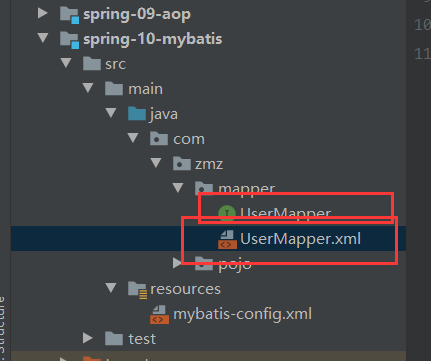
-
别名,mapper映射,以及pom中的build忘记:
<!--别名--> <typeAliases> <package name="com.zmz.pojo"/> </typeAliases> <!--mapper映射--> <mappers> <mapper class="com.zmz.mapper.UserMapper"/> </mappers> <!--pom中的build--> <!--再buil中配置resources,来防止我们资源导出失败的问题--> <build> <resources> <resource> <directory>src/main/resources</directory> <includes> <include>**/*.properties</include> <include>**/*.xml</include> </includes> <filtering>true</filtering> </resource> <resource> <directory>src/main/java</directory> <includes> <include>**/*.properties</include> <include>**/*.xml</include> </includes> <filtering>true</filtering> </resource> </resources> </build>
她所对应的错误:

-
配置文件名字忘记:mybatis-config.xml,记成了spring-mybatis.xml文件了;
12.2、mybatis-spring
-
编写数据源配置
-
sqlSessionFactory
-
SqlSessionTemplate
-
需要给接口添加实现类
-
将自己写的实现类注入到spring中
-
测试使用即可!
代码步骤:
-
先编写实体类
public class User { private int id; private String name; private String pwd; public int getId() { return id; } public void setId(int id) { this.id = id; } public String getName() { return name; } public void setName(String name) { this.name = name; } public String getPwd() { return pwd; } public void setPwd(String pwd) { this.pwd = pwd; } @Override public String toString() { return "User{" + "id=" + id + ", name='" + name + '\'' + ", pwd='" + pwd + '\'' + '}'; } }
-
编写mapper接口
public interface UserMapper { public List<User> getUserList(); }
-
编写mapper.xml文件
<?xml version="1.0" encoding="UTF-8" ?> <!DOCTYPE mapper PUBLIC "-//mybatis.org//DTD Mapper 3.0//EN" "http://mybatis.org/dtd/mybatis-3-mapper.dtd"> <!--configuration核心配置文件--> <mapper namespace="com.zmz.mapper.UserMapper"> <select id="getUserList" resultType="User"> select * from mybatis.user </select> </mapper>
-
编写spring-dao.xml配置文件:放置的都是一些原来mybatis-config.xml配置文件中比较固定的配置
<?xml version="1.0" encoding="UTF-8"?> <beans xmlns="http://www.springframework.org/schema/beans" xmlns:xsi="http://www.w3.org/2001/XMLSchema-instance" xmlns:aop="http://www.springframework.org/schema/aop" xsi:schemaLocation="http://www.springframework.org/schema/beans https://www.springframework.org/schema/beans/spring-beans.xsd http://www.springframework.org/schema/aop https://www.springframework.org/schema/aop/spring-aop.xsd"> <!--让这个spring-dao.xml管理mybatis的文件专门放置固定的配置--> <!--DataSource:使用Spring的数据源替换Mybatis的配置 c3p0 dbcp druid 我们这里使用Spring提供的JDBC: org.springframework.jdbc.datasource.DriverManagerDataSource --> <bean id="dataSource" class="org.springframework.jdbc.datasource.DriverManagerDataSource"> <property name="driverClassName" value="com.mysql.jdbc.Driver"/> <property name="url" value="jdbc:mysql://localhost:3306/mybatis?useSSL=true&useUnicode=true&characterEncoding=UTF-8"/> <property name="username" value="root"/> <property name="password" value="root"/> </bean> <!--sqlSessionFactory--> <bean id="sqlSessionFactory" class="org.mybatis.spring.SqlSessionFactoryBean"> <property name="dataSource" ref="dataSource"/> <!--绑定Mybatis配置文件--> <property name="configLocation" value="classpath:mybatis-config.xml"/> <property name="mapperLocations" value="classpath:com/zmz/mapper/*.xml"/> </bean> <!--SqlSessionTemplate:就是我们使用的sqlSession--> <bean id="sqlSessionTemplate" class="org.mybatis.spring.SqlSessionTemplate"> <!--只能使用构造器注入sqlSessionFactory,因为他没有set方法--> <constructor-arg index="0" ref="sqlSessionFactory"/> </bean> </beans>
-
编写接口实现类(两种方式)
第一种:
public class UserMapperImpl implements UserMapper { //我们原来所有的操作都是使用sqlSession,而现在全部变为sqlSessionTemplate private SqlSessionTemplate sqlSessionTemplate; public void setSqlSessionTemplate(SqlSessionTemplate sqlSessionTemplate) { this.sqlSessionTemplate = sqlSessionTemplate; } public List<User> getUserList() { UserMapper mapper = sqlSessionTemplate.getMapper(UserMapper.class); List<User> userList = mapper.getUserList(); return userList; } }
第二种:
//方式二:继承SqlSessionDaoSupport类,直接获取sqlSession进行调用 public class UserMapperImpl2 extends SqlSessionDaoSupport implements UserMapper { public List<User> getUserList() { return getSqlSession().getMapper(UserMapper.class).getUserList(); } }
-
配置mybatis-config.xml文件:放置mybatis文件别名设置,settings设置
<?xml version="1.0" encoding="UTF-8" ?> <!DOCTYPE configuration PUBLIC "-//mybatis.org//DTD Config 3.0//EN" "http://mybatis.org/dtd/mybatis-3-config.dtd"> <!--以后这个文件可以专门放setting配置--> <configuration> <typeAliases> <package name="com.zmz.pojo"/> </typeAliases> <!-- <settings>--> <!-- <setting name="" value=""/>--> <!-- </settings>--> </configuration>
-
配置applicationContext.xml文件:放置spring托管的注入bean
对应两种接口实现类,bean注入也不同(代码如下,可以看不同)
<?xml version="1.0" encoding="UTF-8"?> <beans xmlns="http://www.springframework.org/schema/beans" xmlns:xsi="http://www.w3.org/2001/XMLSchema-instance" xmlns:aop="http://www.springframework.org/schema/aop" xsi:schemaLocation="http://www.springframework.org/schema/beans https://www.springframework.org/schema/beans/spring-beans.xsd http://www.springframework.org/schema/aop https://www.springframework.org/schema/aop/spring-aop.xsd"> <!--导入spring-dao.xml配置文件使用,将其变为一个通用工具类--> <import resource="spring-dao.xml"/> <bean id="userMapper" class="com.zmz.mapper.UserMapperImpl"> <property name="sqlSessionTemplate" ref="sqlSessionTemplate"/> </bean> <!--方式二的property不一样--> <bean id="userMapper2" class="com.zmz.mapper.UserMapperImpl2"> <property name="sqlSessionFactory" ref="sqlSessionFactory"/> </bean> </beans>
13、声明式事务
1、回顾事务
-
把一组业务当成一个业务来做;要么都成功,要么都失败!
-
事务在项目开发中,十分的重要,涉及到数据的一致性问题,不能马虎!
-
确保完整性和一致性;
事务ACID原则:
-
原子性
-
一致性
-
隔离性
-
多个事务可能操作同一个资源,防止数据损坏
-
-
持久性
-
事务一旦提交,无论系统发生什么问题,结果都不会再被影响,被持久化的写到存储器中!
-
2、spring中的事务管理
-
声明式事务:AOP应用,不影响代码
-
编程式事务:需要在代码中进行事务的管理
事务配置代码在spring-dao.xml中:
<!--配置声明式事务--> <bean id="transactionManager" class="org.springframework.jdbc.datasource.DataSourceTransactionManager"> <property name="dataSource" ref="dataSource"/> </bean> <!--结合AOP实现事务的织入--> <!--配置事务通知:--> <tx:advice id="txAdvice" transaction-manager="transactionManager"> <!--给哪些方法配置事务--> <!--配置事务的传播特性:new propagation= --> <tx:attributes> <tx:method name="add" propagation="REQUIRED"/> <tx:method name="update" propagation="REQUIRED"/> <tx:method name="delete" propagation="REQUIRED"/> <tx:method name="query" read-only="true"/> <tx:method name="*" propagation="REQUIRED"/> </tx:attributes> </tx:advice> <!--配置事务切入--> <aop:config> <aop:pointcut id="txPointCut" expression="execution(* com.zmz.mapper.*.*(..))"/> <aop:advisor advice-ref="txAdvice" pointcut-ref="txPointCut"/> </aop:config>
配置了之后,如果方法错误,则这个方法不会对数据库产生任何影响;
为什么需要事务?
-
如果不配置事务,可能存在数据提交不一致的情况下;
-
如果我们不在Spring中去配置声明式事务,我们就需要在代码中手动配置事务!
-
事务在项目的开发中十分重要,设计到数据的一致性和完整性问题,不容马虎!
———宝剑锋从磨砺出,梅花香自苦寒来!

